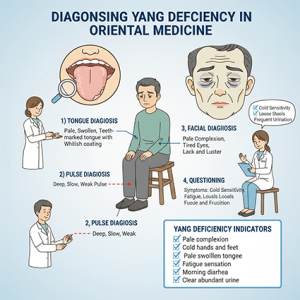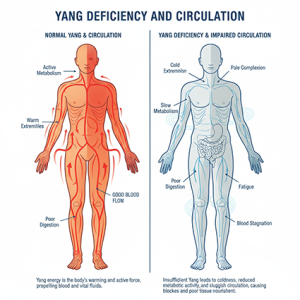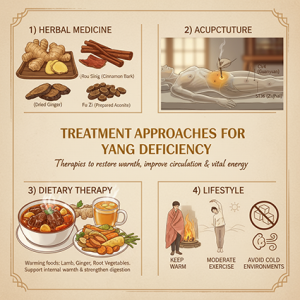In Oriental medicine, Yang energy is the body’s warming, activating, and motivating force. A deficiency of this fundamental energy, particularly originating from the Kidneys, and the subsequent impairment of Qi and blood circulation, are considered root causes of a wide spectrum of health issues.



- The Core Organ: Kidney Yang Deficiency (腎陽虛)
The Kidneys are regarded as the “root of life” as they store the body’s foundational energy, known as Jing (Essence), and are the primary source of Yang Qi for the entire body.
Key Functions: Govern growth, development, reproduction, bone marrow production, and brain health. They provide the thermal energy for all bodily functions.
Impact of Deficiency: When Kidney Yang is deficient, it leads to a systemic decline in warmth and energy, causing a variety of “cold” and “depletion” syndromes.
Symptoms of Kidney Yang Deficiency Include:
Reproductive & Urinary Systems:
Men: Erectile dysfunction, low libido, premature ejaculation.
Women: Infertility, cold uterus, painful or irregular menstruation.
General: Frequent urination, clear urine, nocturia (waking at night to urinate).
Systemic “Cold” Symptoms:
Chronic fatigue and lethargy.
Aversion to cold, feeling colder than others.
Cold extremities (hands and feet).
Lower back and knee pain or weakness (the Kidneys “govern” this area).
Aging & Decline:
Premature gray hair, hair loss.
Tinnitus (ringing in the ears), often with a high-pitched sound.
Poor memory, cognitive decline.
Osteoporosis.
- Consequences of Impaired Circulation: Blood Stasis & Phlegm-Dampness
Yang energy is the engine that drives the circulation of Qi (vital energy) and Blood (血). A Yang deficiency means this engine is weak, leading to stagnation and the accumulation of pathological waste products.
Blood Stasis (瘀血 – Ŭhyeol): Stagnant, congealed blood that fails to circulate smoothly.
Phlegm-Dampness (痰飮 – Dam-eum): A thick, turbid metabolic waste product that accumulates due to impaired fluid transformation (a function of Yang energy).
Diseases and Symptoms Related to Circulatory Disorders:
Cardiovascular & Peripheral Issues:
Cold, numb, or tingling limbs.
Raynaud’s syndrome.
Severe: Chest pain, angina, high risk of myocardial infarction (heart attack) or stroke (cerebral infarction).
Pain Disorders:
Fixed, stabbing pains (characteristic of Blood Stasis).
Stiff, aching muscles and joints, often worsened by cold weather (characteristic of Phlegm-Dampness and Cold).
Digestive Disorders:
Poor appetite, bloating after meals.
Loose stools or diarrhea (due to “Spleen Yang deficiency,” which is closely related to Kidney Yang).
Skin Disorders:
Dry, itchy skin, eczema, or poor wound healing due to inadequate nourishment from stagnant blood.
Respiratory & Immune Weakness:
Weak immunity, easily catching colds.
Chronic rhinitis, often with clear phlegm.
Shortness of breath, asthma.
Conclusion & Treatment Principle
The conditions of Yang deficiency and circulatory disorders are intrinsically linked; one often begets and exacerbates the other.
The goal of Oriental medicine treatment is to:
Tonify and Warm Kidney Yang (溫補腎陽) to address the root source of energy.
Promote Qi and Blood Circulation (行氣活血) to remove stagnation and pathological waste (Blood Stasis, Phlegm).
Strengthen the Spleen to improve digestion and resolve Dampness.
If you are experiencing these symptoms, it is essential to receive an accurate diagnosis from a qualified practitioner. Treatment is highly individualized and may involve herbal medicine, acupuncture, moxibustion (a key therapy for warming Yang), and dietary adjustments tailored to your specific constitution and pattern of imbalance.